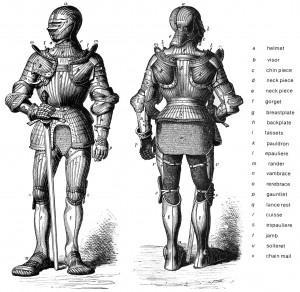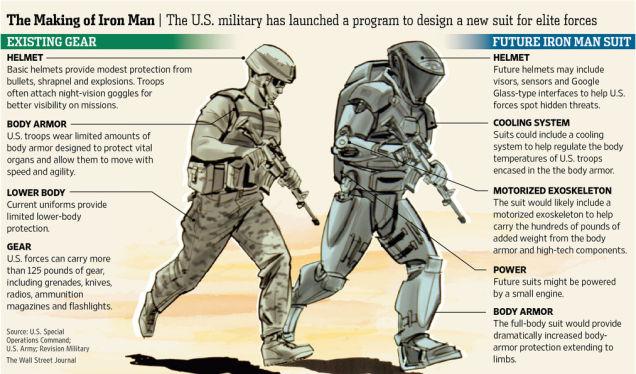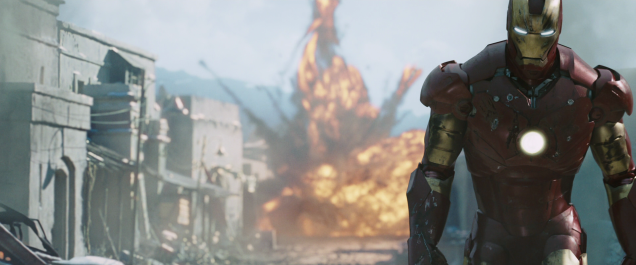There is a long history of innovation that has benefited civilian life, driven by military research and development. This time, the military is taking a cue from something that was designed merely to entertain the masses: Iron Man.
 As weapons and tactics have changed, so too has the protective gear worn by soldiers in combat. Efforts have been made by all warring societies across time to create better combat protection. From folded paper, to leather, to suits of chain mail, each has served its purpose and then driven the enemy to develop weapons that would render it useless. The suit of armor has given way to the ballistic vest, but they aren’t perfect either, as they are susceptible to stabbing weapons for example, and the fact remains that any casualty is too many. It should come as no surprise then that the military is looking for a new way to suit up its soldiers.
As weapons and tactics have changed, so too has the protective gear worn by soldiers in combat. Efforts have been made by all warring societies across time to create better combat protection. From folded paper, to leather, to suits of chain mail, each has served its purpose and then driven the enemy to develop weapons that would render it useless. The suit of armor has given way to the ballistic vest, but they aren’t perfect either, as they are susceptible to stabbing weapons for example, and the fact remains that any casualty is too many. It should come as no surprise then that the military is looking for a new way to suit up its soldiers.
Medieval soldiers wore a suit of armor, sometimes made of iron, but do we really want to weigh down modern soldiers with something like that? In actuality, a medieval suit of armor generally weight between 45 and 55 pounds – less than what soldiers have been carrying into combat since the 19th century. Maybe a full body suit of armor isn’t such a bad idea then. While, nobody is proposing that we turn our soldiers back into knights in shining armor. There is interest in developing a Tactical Assault Light Operator Suit (TALOS), and the US military has contracted the special effects team from Iron Man to design it.
 This isn’t as easy as mass-producing the one used on the set, which was, of course, just a prop. A fully functional version of the suit would actually weighs nearly 400 lbs., (it would require 365 lbs. of batteries alone) significantly more than the bulkiest of medieval armor. Even if the suit were to lighten up a bit, it would still require a power exoskeleton to support it so that the soldier could maneuver during her/his operations. Exoskeletons are currently a reality, though they cannot manage 400 lbs., and are created for medical use, meaning this is not a pipe dream. Russ Angold of Ekso Bionics cautions:
This isn’t as easy as mass-producing the one used on the set, which was, of course, just a prop. A fully functional version of the suit would actually weighs nearly 400 lbs., (it would require 365 lbs. of batteries alone) significantly more than the bulkiest of medieval armor. Even if the suit were to lighten up a bit, it would still require a power exoskeleton to support it so that the soldier could maneuver during her/his operations. Exoskeletons are currently a reality, though they cannot manage 400 lbs., and are created for medical use, meaning this is not a pipe dream. Russ Angold of Ekso Bionics cautions:
“Hollywood has definitely made the Iron Man suit impossibly thin, impossibly light, impossibly agile, and impossibly energy efficient. So we’re really trying to solve the problem and ask the question: what would Iron Man look like if it was real?”
 To answer this question, the US military has already spent approximately $10 million dollars and has budgeted a further $70 million for the project. While this may seem like a great deal of money, it’s pocket change when it comes to Pentagon projects. A defense official, who declined to have his name revealed, said:
To answer this question, the US military has already spent approximately $10 million dollars and has budgeted a further $70 million for the project. While this may seem like a great deal of money, it’s pocket change when it comes to Pentagon projects. A defense official, who declined to have his name revealed, said:
“To do it right, they need about a billion dollars. Twenty million dollars a year in an R&D budget – you couldn’t even develop a pencil on that.”
The military is hoping that its widely acknowledged history of over spending will be reversed in this project and is approaching the project a bit differently. Rather than utilizing the typical defense contracting approaches used in the past, they are assembling a think tank and harnessing the power of 3D printing for rapid prototyping.
 Being able to create the pieces of the suit as quickly as 3D printing allows, gives more time for iterative improvement and allows for more realistic prototyping. While they will most likely not end up with something as polished as the movie’s Iron Man, it could be the first step to an entirely different way of thinking about what gear is necessary for battle. It is yet another demonstration of the way in which 3D printing changes the world around us.
Being able to create the pieces of the suit as quickly as 3D printing allows, gives more time for iterative improvement and allows for more realistic prototyping. While they will most likely not end up with something as polished as the movie’s Iron Man, it could be the first step to an entirely different way of thinking about what gear is necessary for battle. It is yet another demonstration of the way in which 3D printing changes the world around us.
As we work toward creating a more impenetrable suit to keep soldiers safe, we must stop to think about what that will mean when the technology is widely available and how that will eventually drive the weapons of the future as well. Maybe 3D technologies can help provide an architecture for peace that will, if not eliminate, at least reduce the need for such protective suits. Brian Dowling, a former soldier working on the TALOS project, is not sure that the end result will be worthy of Hollywood, “but you’ll have some greatly improved technology along the way.”
Do you think that the military can succeed with this project on such a small budget, with the help of 3D printing? Let us know your opinion on this suit in the 3D printed Iron Man forum thread on 3DPB.com.
Subscribe to Our Email Newsletter
Stay up-to-date on all the latest news from the 3D printing industry and receive information and offers from third party vendors.
You May Also Like
3D Printing Financials: Fathom Struggles in Financial Quicksand During Critical Transition
Facing a year of key transitions and financial pressures, Fathom (Nasdaq: FTHM) has filed its annual report for 2023 with the U.S. Securities and Exchange Commission (SEC). The document outlines...
Latest Earnings Overview for Australian 3D Printing Firms Titomic and AML3D
Australian 3D printing manufacturing firms Titomic (ASX: TTT) and AML3D (ASX: AL3) reported their financial results for the period from July to December 2023, marking the first half of their...
3D Printing Webinar and Event Roundup: April 7, 2024
Webinars and events in the 3D printing industry are picking back up this week! Sea-Air-Space is coming to Maryland, and SAE International is sponsoring a 3D Systems webinar about 3D...
3D Printing Financials: Unpacking Farsoon and BLT’s 2023 Performance
In the Chinese 3D printing industry, two companies, Farsoon (SHA: 688433) and Bright Laser Technologies, or BLT (SHA: 688333), have recently unveiled their full-year earnings for 2023. Farsoon reported increases...































